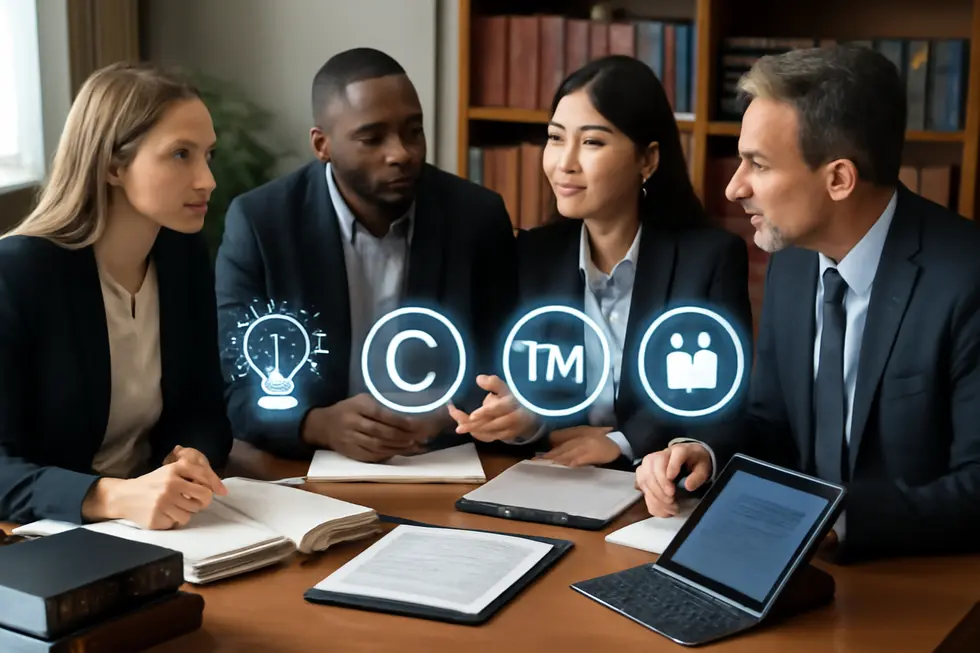Introduction
Intellectual property (IP) is a cornerstone asset for business owners seeking to safeguard and grow their enterprises. It encompasses legal rights that protect creations such as inventions, designs, branding, and original works. Navigating the multifaceted landscape of IP is essential as these intangible assets drive innovation, competitive advantage, and revenue streams. This guide begins with foundational knowledge of IP’s legal framework and moves through detailed insights into the major types of IP property. It addresses practical strategies for managing IP in collaborative environments, ensuring clarity and protection in contractual relationships. Further, it explores how businesses can effectively commercialize their IP through buying, selling, and licensing arrangements. Finally, the guide confronts emerging challenges, notably legal uncertainties posed by AI-generated content, equipping business owners to anticipate and respond to evolving IP dynamics. Each chapter builds upon the previous, delivering a holistic understanding that empowers informed decision-making and proactive IP stewardship.
Tables of Contents
Chapter 1: Introduction to IP Property: Foundations and Legal Frameworks
- Core Principles and Legal Protections Shaping Intellectual Property Rights
- Unlocking Innovation: The Critical Role and Legal Complexities of Patents in Intellectual Property
- Understanding Copyrights: Protecting Original Creations Within IP Frameworks
- Defending Brand Identity and Competitive Edge: The Role of Trademarks and Trade Secrets
- Navigating Technological Innovation and Economic Forces Shaping IP Rights
Chapter 2: Types of IP Property: Copyrights, Patents, Trademarks, and Trade Secrets
- Protecting Creative Expression: The Role and Reach of Copyright in Intellectual Property
- Patents: Driving Innovation Through Exclusive Protection of Inventions
- How Trademarks Shape Brand Identity and Protect Consumer Trust
- Trade Secrets: The Hidden Pillars of Sustained Business Advantage
- Balancing Legal Protections and Economic Impact Across Copyrights, Patents, Trademarks, and Trade Secrets
Chapter 3: Navigating Collaborative IP Ownership and Accountability in Intellectual Property Management
- Clarifying Roles and Rights: Establishing Definitive IP Ownership in Collaborative Contracts
- Crafting Clear IP Agreements: Essential Elements to Secure Collaborative Innovations
- Cultivating Clear and Trustworthy Communication for Seamless IP Collaboration
- Driving IP Success Through Performance Metrics and Collaborative Accountability
- Clarifying Ownership and Managing Third-Party Intellectual Property Contributions
Chapter 4: Commercialization of IP Property: Buying, Selling, and Licensing Practices
- Strategic Acquisition of Intellectual Property: Navigating Purchases and Licenses for Commercial Success
- Navigating the Sale of Intellectual Property: Balancing Ownership, Risk, and Revenue
- Mastering IP Licensing: Strategic Approaches to Monetize Intellectual Property Assets
- Tailoring IP Commercialization Strategies Across Industry Landscapes
- Navigating Complex Legal and Due Diligence Challenges in IP Commercialization
Chapter 5: Navigating Legal Complexities of AI-Driven Intellectual Property
- Decoding Copyright Uncertainties in the Era of AI-Generated Creations
- Navigating Patent Law Amidst AI Innovation: Inventorship, Ownership, and Legal Uncertainty
- Navigating Legal Shifts: Human Authorship and Regulatory Innovations in AI-Driven Intellectual Property
- Navigating the Economic Impact of AI Innovations on IP Rights and Legal Reform
- Navigating Ethical Complexities and Societal Impacts in AI-driven Intellectual Property
Chapter 1: Introduction to IP Property: Foundations and Legal Frameworks

1. Core Principles and Legal Protections Shaping Intellectual Property Rights
Intellectual Property (IP) safeguards creations of the mind through distinct legal categories that balance innovation with public interest. The core types include patents, protecting novel inventions; copyrights, securing original artistic and literary works; trademarks, distinguishing brands and businesses; and trade secrets, guarding confidential competitive information. Each form grants exclusive rights that enable creators and companies to control use, reproduction, and distribution, ensuring economic incentives and legal remedies. These protections often overlap to strengthen commercial strategies, such as combining patents and trademarks in licensing. IP laws vary internationally and adapt to emerging challenges, underscoring the importance of a comprehensive understanding of these foundational rights. For more insights on trademark protection relevant to businesses, see trademark protection for business name and logo.
2. Unlocking Innovation: The Critical Role and Legal Complexities of Patents in Intellectual Property
Patents serve as vital instruments in intellectual property, granting inventors exclusive rights to their novel creations, typically for up to 20 years. These rights prevent unauthorized making, using, or selling of inventions within a specific jurisdiction. Patents encompass utility, design, and plant types, each protecting different aspects of innovation. Securing a patent requires proving novelty, usefulness, and non-obviousness, often necessitating rigorous prior art searches. The legal framework further demands vigilant enforcement to prevent infringement. Recent shifts, such as the “first-to-file” system and the role of specialized tribunals, have refined patent strategies. International protection remains complex, managed through treaties like the PCT. Patents thus carefully balance incentivizing creativity with public access, forming a cornerstone of IP protection strategies. For deeper insight into brand protections related to patents, consider exploring trademark topics.
3. Understanding Copyrights: Protecting Original Creations Within IP Frameworks
Copyrights protect original works by granting creators exclusive rights to reproduce, distribute, and adapt their creations. Unlike patents, copyrights arise automatically upon creation of a work fixed in a tangible medium, covering literary, musical, artistic, and audiovisual expressions. The legal framework, rooted in the U.S. Constitution and shaped by the Copyright Act of 1976, balances creators’ exclusive rights with public interests through doctrines like fair use. This distinction between ideas and their expression is critical, ensuring only the unique expression receives protection. As digital media evolve, copyright laws adapt to maintain this equilibrium, supporting innovation while safeguarding creative ownership. For further detail, explore the concept with comprehensive copyright guidance for business owners.
4. Defending Brand Identity and Competitive Edge: The Role of Trademarks and Trade Secrets
Trademarks and trade secrets are vital pillars in intellectual property protection, each guarding different assets critical to business success. Trademarks distinguish goods or services through unique names, logos, and symbols, securing consumer recognition and preventing market confusion. Their protection relies on registration with authorities like the USPTO and careful selection of distinctive marks. Conversely, trade secrets protect confidential information—such as formulas or business strategies—that offer a competitive advantage. Trade secrets require proactive secrecy measures including non-disclosure agreements and secure handling rather than formal registration. Together, they empower businesses to safeguard brand identity and valuable proprietary knowledge, making these tools indispensable components within IP property frameworks. For insights on trademark protection strategies, see trademark name and logo protection.
5. Navigating Technological Innovation and Economic Forces Shaping IP Rights
Intellectual property rights are increasingly influenced by rapid technological advances and global economic shifts. Technologies like artificial intelligence and cloud computing challenge traditional IP frameworks by raising questions about authorship, data sovereignty, and cross-border regulatory compliance. The intensifying US-China competition exemplifies how geopolitical interests intertwine with technology control, fragmenting the digital landscape and complicating IP enforcement worldwide. Economically, IP acts as a strategic asset vital to market differentiation and innovation-driven growth. However, emerging models based on AI-generated data and services expose gaps in governance and legal clarity, especially for smaller enterprises. Effectively managing IP today requires understanding these tensions between securing innovation benefits and navigating evolving global rules. For more on protecting intangible assets within business, see trademark protections for brand identity.
Chapter 2: Types of IP Property: Copyrights, Patents, Trademarks, and Trade Secrets

1. Protecting Creative Expression: The Role and Reach of Copyright in Intellectual Property
Copyright safeguards original works fixed in tangible forms, granting creators exclusive rights to reproduce, distribute, perform, display, and create derivatives from their creations. Unlike ideas, copyright protects the unique expression of ideas across diverse media including literature, music, art, films, and software. These protections last typically for the author’s life plus several decades, after which works enter the public domain. Copyright not only incentivizes creative endeavors by securing economic benefits but also balances public interest through limited duration. Enforcement challenges include digital infringement and fair use interpretations. Distinct from patents and trademarks, copyright focuses on artistic and literary expression, making it foundational in preserving creators’ rights and inspiring ongoing cultural innovation. For a detailed overview, see more on copyright definition for business owners.
2. Patents: Driving Innovation Through Exclusive Protection of Inventions
Patents safeguard novel inventions by granting exclusive rights to their creators for about 20 years, covering processes, machines, compositions, and improvements. This temporary monopoly encourages investment in research and development, fueling technological progress. Utility patents protect functional innovations, design patents focus on ornamental features, and plant patents cover new plant varieties. By enabling inventors to license their patents, technology transfer is accelerated, bridging innovation and commercialization. Patents also provide a legal foundation to prevent unauthorized use, ensuring inventors can secure financial returns and attract funding. Integrating patent strategy within the broader IP framework enhances competitive advantage and supports sustained growth. For detailed guidance, resources like the categories of intellectual property rights offer valuable insights.
3. How Trademarks Shape Brand Identity and Protect Consumer Trust
Trademarks serve as powerful identifiers that define a brand’s identity and differentiate its goods or services in the marketplace. By protecting logos, names, slogans, and symbols, trademarks ensure consistent recognition while signaling quality and reliability to consumers. This trust cultivates loyalty and sustains business growth by reinforcing the brand’s reputation. Equally important, trademarks safeguard consumers by preventing confusion and counterfeit products, allowing buyers to confidently associate products with their genuine source. Legal trademark registration grants exclusive rights and enables enforcement against infringement, thereby preserving the brand’s integrity. For businesses seeking deeper guidance, exploring trademark protection resources can clarify how these assets bolster market presence and consumer confidence. For more insights, refer to trademark protection for business name and logo.
4. Trade Secrets: The Hidden Pillars of Sustained Business Advantage
Trade secrets play a crucial role in preserving a company’s competitive edge by protecting confidential knowledge that competitors cannot easily replicate. Unlike patents, trade secrets avoid public disclosure and offer potentially indefinite protection, as long as secrecy is maintained. These secrets can consist of formulas, processes, or methods that deliver economic value, such as famous undisclosed recipes or proprietary algorithms. Effective protection hinges on rigorous confidentiality measures, including limited access, secure storage, and non-disclosure agreements. By embedding trade secrets within their intellectual property strategy, businesses safeguard unique assets that boost market position and foster ongoing innovation. For further guidance on strategic IP management, see the resource on common types of intellectual property rights.
5. Balancing Legal Protections and Economic Impact Across Copyrights, Patents, Trademarks, and Trade Secrets
Intellectual property types—copyrights, patents, trademarks, and trade secrets—each provide distinct legal safeguards and economic advantages that underpin innovation and commerce. Copyrights protect the tangible expression of creative works, granting creators exclusive rights typically lasting a lifetime plus decades, which fuels cultural and software-related industries. Patents offer inventors a 20-year monopoly on novel inventions, incentivizing research investment and innovation, while their economic value hinges on enforceability and market dynamics. Trademarks safeguard brand identifiers indefinitely when used commercially, driving consumer trust and representing significant intangible assets. Trade secrets protect confidential business knowledge without registration, granting sustained competitive edges when secrecy is maintained. Together, these IP forms constitute vital assets in a global market where effective legal frameworks amplify their economic potential, encouraging ongoing creativity and strategic business growth. For more insight on copyright economics, visit copyright definition economics business.
Chapter 3: Navigating Collaborative IP Ownership and Accountability in Intellectual Property Management

1. Clarifying Roles and Rights: Establishing Definitive IP Ownership in Collaborative Contracts
In collaborative and contractual environments, establishing clear intellectual property ownership and accountability is essential to safeguard innovation and prevent disputes. Organizations must first inventory existing IP brought by each party to avoid confusion. Defining ownership of newly created IP—including patent filing responsibilities—ensures aligned expectations. Formal agreements should address confidentiality, licensing, dispute resolution, and evolving innovations, preventing unintended co-ownership. Assigning clear roles, such as intellectual property officers and cross-functional teams, strengthens governance by linking specific tasks to accountable owners. This approach fosters clarity, reduces overlap, and enhances strategic IP management across functions. Ensuring such thorough frameworks enables partnerships to innovate confidently while protecting valuable IP assets. For detailed insights on contractual provisions protecting creative works, consider resources like copyright language for business owners.
2. Crafting Clear IP Agreements: Essential Elements to Secure Collaborative Innovations
Effective management of intellectual property in collaborations hinges on well-drafted agreements that specify ownership of both existing and newly created IP. These contracts must clearly define usage rights, outlining geographic and field-of-use boundaries to prevent misunderstandings. Confidentiality clauses protect sensitive information exchanged during partnerships, while exit provisions address the handling of IP upon termination, ensuring smooth transitions. Including dispute resolution mechanisms, such as mediation or arbitration, anticipates conflicts and preserves business relationships. Aligning these agreements with strategic business goals and maintaining continuous IP oversight fosters transparency and proactive protection. Joint ownership and licensing arrangements require careful attention to detail to safeguard all parties’ interests. For guidance on structuring such agreements, see detailed resources on best practices for assigning IP ownership in strategic partnerships.
3. Cultivating Clear and Trustworthy Communication for Seamless IP Collaboration
Transparent communication underpins successful IP management in collaborative and contractual settings by ensuring all parties clearly understand their IP rights and obligations. Establishing rigorous agreements with detailed confidentiality and ownership clauses prevents disputes and protects proprietary information. Regular discussions and monitoring maintain alignment, addressing IP developments and compliance proactively. Framing compliance as a shared responsibility fosters cooperation instead of confrontation, supported by data insights to identify and resolve risks early. Leveraging technology further enhances clarity and trust, streamlining IP processes across collaborators and enabling data-driven decisions that safeguard intellectual property effectively. This strategic openness promotes innovation while respecting all contributors’ rights. For further insights on protecting intellectual property within business frameworks, see company intellectual property protection.
4. Driving IP Success Through Performance Metrics and Collaborative Accountability
Effectively managing intellectual property in collaborative and contractual environments hinges on deploying clear performance metrics that align with shared objectives. Metrics like patent pendency ratios, maintenance costs per asset, and licensing revenue growth enable organizations to assess efficiency, value, and commercialization success across joint ventures and partnerships. Setting SMART goals ensures accountability and focus, while monitoring compliance through transparent reporting cultivates trust between licensors and licensees. Cross-functional teams integrate legal, R&D, and business insights to interpret data-driven trends, uncovering opportunities to optimize IP portfolios and contractual arrangements. Regular audits and well-defined ownership terms sustain clarity, embedding IP stewardship as a collective priority. This strategic, metric-driven approach ensures that shared intellectual assets are both protected and leveraged effectively, maximizing collaborative innovation outcomes.
5. Clarifying Ownership and Managing Third-Party Intellectual Property Contributions
Effectively managing third-party contributions in collaborative IP environments requires clear, upfront contractual agreements that precisely define ownership and usage rights. Distinguishing between pre-existing background IP and newly created foreground IP avoids confusion and legal disputes. When engaging freelancers or contractors, written IP assignment clauses are essential to secure ownership and protect business interests. Fair compensation for unequal IP contributions, alongside specified usage limits such as geographic scope or licensing terms, prevents friction among collaborators. Assigning responsibilities for IP maintenance and enforcement, coupled with indemnification provisions, manages risk from infringement claims. Continuous communication reinforces clarity on emerging IP and sustains protection across partnerships. For deeper insights, see guidance on IP risk in collaborations.
Chapter 4: Commercialization of IP Property: Buying, Selling, and Licensing Practices

1. Strategic Acquisition of Intellectual Property: Navigating Purchases and Licenses for Commercial Success
Acquiring intellectual property (IP) rights plays a pivotal role in commercialization by enabling businesses to leverage innovations and creative works. Buyers may opt for outright purchase (assignment), gaining full ownership and control, but at the cost of a one-time payment and assuming future risks. Alternatively, licensing agreements provide flexible access through exclusive or non-exclusive rights, generating ongoing royalties while the original owner retains ownership. Technology transfer combines aspects of sales and licensing, particularly in academia, facilitating the market entry of novel inventions. Collaborations and joint ventures can also broaden commercialization reach by sharing resources and IP assets. Thorough due diligence and valuation are essential to confirm ownership, enforceability, and relevance, guiding strategic decisions that balance control, risk, and long-term revenue. For deeper insight into IP ownership and protection, exploring dedicated resources on company intellectual property protection is invaluable.
2. Navigating the Sale of Intellectual Property: Balancing Ownership, Risk, and Revenue
Navigating the Sale of Intellectual Property: Balancing Ownership, Risk, and Revenue
Selling intellectual property involves either transferring full ownership or granting usage rights through licensing. Outright sales provide immediate capital and transfer all commercialization risks but require relinquishing control and future earnings. In contrast, licensing preserves ownership while generating ongoing royalties, leveraging partners’ market expertise, and lowering capital demands. Licensing arrangements vary from exclusive to non-exclusive rights and are common in industries like biotechnology and software. Other commercialization paths include forming startups, entering joint ventures, or using technology transfer agreements. Meticulous due diligence—verifying ownership, evaluating encumbrances, and assessing market potential—is essential. Choosing between selling or licensing IP depends on strategic goals, risk tolerance, and resource capacity. For businesses exploring IP rights, understanding these commercialization avenues ensures informed, valuable decisions. Learn more about protecting your IP assets by reviewing trademark fundamentals and legal practices.
3. Mastering IP Licensing: Strategic Approaches to Monetize Intellectual Property Assets
Licensing intellectual property enables owners to retain control while generating income through royalties or fees. Successful licensing begins with assessing the IP’s market viability and selecting suitable licensees. Common license types—exclusive, non-exclusive, and sole—offer varied control and revenue potentials. Negotiations hinge on fair royalty structures aligned with the asset’s valuation, often supported by clear data on patent validity and market scope. Licensing also facilitates broader commercialization strategies, such as technology transfer and cross-licensing, optimizing IP’s value without transferring ownership. This balanced approach allows creators to leverage their innovations sustainably while navigating complex legal agreements designed to protect all parties.
4. Tailoring IP Commercialization Strategies Across Industry Landscapes
Commercializing intellectual property requires nuanced approaches that reflect each industry’s unique dynamics and IP characteristics. For instance, the semiconductor sector relies heavily on layered IP protection and aggressive enforcement, using licensing to original equipment manufacturers for competitive advantage. Biotechnology and software industries favor royalty-based, exclusive or cross-licensing models that support collaborative innovation and revenue sharing. Advanced therapies deploy layered IP frameworks separating platform technology from product-specific rights to maximize flexibility and exclusivity. Startup entities often opt for direct patent sales to quickly monetize inventions, while academia commonly engages in technology transfer agreements. Effective commercialization hinges on comprehensive IP valuation, meticulous negotiation of royalties or lump sums, and vigilant enforcement to uphold IP market value. For insight into licensing foundations, see the detailed discussion on copyright language for business owners.
5. Navigating Complex Legal and Due Diligence Challenges in IP Commercialization
Successful commercialization of intellectual property demands meticulous legal due diligence to confirm clear ownership and enforceability of rights. Investigating the entire chain of title, identifying encumbrances, and reviewing licensing agreements ensures proper transferability and usage rights while avoiding hidden liabilities. Protection of trade secrets requires continuous confidentiality measures, such as employee agreements and security policies, to maintain value. Emerging technologies, especially AI-generated content, create new uncertainties since existing IP laws often lack clarity on ownership and protection. Additionally, compliance with antitrust regulations is critical to prevent anti-competitive practices in licensing deals. Assessing market risks and strategically structuring transactions—whether sales, licenses, or cross-licenses—further optimize value while mitigating legal pitfalls. For a deeper look at licensing essentials, see trademark nuances explained in trademark protection for business name and logo.
Chapter 5: Navigating Legal Complexities of AI-Driven Intellectual Property

1. Decoding Copyright Uncertainties in the Era of AI-Generated Creations
Copyright law faces significant uncertainty with AI-generated content because traditional frameworks assign authorship exclusively to humans. This raises critical questions about whether rights belong to developers, users, or owners of AI systems. Furthermore, many AI models train on vast copyrighted datasets without explicit permissions, triggering infringement concerns. When AI outputs closely mimic original works or styles, distinguishing between inspiration and violation becomes legally challenging. Existing laws such as the DMCA lack provisions suited to AI’s unique role, creating enforcement gaps. Resolving these issues requires updated legislation that clarifies ownership and liability, alongside ethical considerations that balance innovation with creators’ rights. For further understanding, see this detailed discussion on copyright law nuances relevant to businesses.
2. Navigating Patent Law Amidst AI Innovation: Inventorship, Ownership, and Legal Uncertainty
Patent law faces profound challenges as AI-generated inventions defy traditional concepts of inventorship and ownership. Laws require inventors to be human, yet autonomous AI systems increasingly produce novel solutions. This legal ambiguity complicates patent filings and enforcement, demanding careful documentation of human involvement. Additionally, AI-assisted patent drafting risks bias and uneven quality, necessitating rigorous human scrutiny. Policymakers explore reforms to broaden inventorship definitions and establish AI-specific rights, aiming to preserve innovation incentives while offering clarity. For businesses, clear internal protocols and expert legal guidance are essential to manage risks and disputes. Understanding these complexities is key to securing and leveraging AI-era patent rights effectively. For more insight on intellectual property strategies, visit the categories of intellectual property rights guide.
3. Navigating Legal Shifts: Human Authorship and Regulatory Innovations in AI-Driven Intellectual Property
Legal systems worldwide are evolving to address AI-generated content within intellectual property (IP) frameworks. Courts increasingly require clear evidence of human creative input to establish copyright, as seen in rulings like that of the Beijing Internet Court, which demands documentation of user involvement in AI-generated works. This approach preserves traditional notions of authorship, excluding AI alone as a rights holder. Regulatory measures also stress transparency and due diligence in using AI content, urging disclosure of AI origins and rigorous infringement checks to mitigate risk. Meanwhile, debates persist on ownership division among AI developers, users, and the AI itself, alongside ethical concerns around authenticity and AI’s role. Emerging flexible legal frameworks and technologies like blockchain aim to adapt IP protections to this new terrain, striving to balance innovation with accountability. For more on balancing creative rights and legal safeguards, see copyright information example for business.
4. Navigating the Economic Impact of AI Innovations on IP Rights and Legal Reform
The rise of AI-generated content reshapes the economic landscape of intellectual property. Reductions in production costs—such as a 30% drop in TV and film expenses—contrast with threats to traditional creative markets, risking significant revenue declines for human creators. For example, unauthorized use of data to train AI models undermines copyright protections, potentially eroding billions in earnings across music and audiovisual sectors. Legal frameworks strain to keep pace, wrestling with issues of AI authorship and ownership amidst lawsuits and regulatory uncertainty. Balancing innovation with ethical and economic considerations demands adaptive laws and strategic oversight, ensuring that AI-driven creativity coexists with sustainable value for creators. For insights on copyright as a fundamental business asset, explore comprehensive resources on copyright economics.
5. Navigating Ethical Complexities and Societal Impacts in AI-driven Intellectual Property
The rise of AI-generated content challenges traditional intellectual property frameworks by blurring authorship and ownership lines, as laws typically require a human creator. This ambiguity complicates rights allocation between AI developers, users, and absent human authors. Ethical concerns intensify with AI training on vast datasets, often without explicit consent, prompting debates over copyright infringement and fair compensation. Transparency requirements seek to inform consumers when content is AI-produced, addressing misinformation risks. Moreover, AI can perpetuate biases, raising questions about fairness and social impact. Accountability remains elusive as assigning liability for harms involves complex considerations, while global jurisdictional disparities call for coordinated legal responses. These intertwined social and ethical dimensions shape ongoing adaptations in IP law to balance innovation with responsible stewardship.
Final thoughts
Intellectual property is a critical asset that business owners must understand and manage proactively. From foundational legal concepts to nuanced types of IP property, each element plays a strategic role in protecting and enhancing business value. Collaborative ventures demand clear contractual management to ensure ownership clarity and prevent disputes. Moreover, effective commercialization through buying, selling, and licensing transforms intangible assets into significant revenue streams. Looking ahead, AI-generated content introduces novel challenges that necessitate adaptive legal perspectives to safeguard IP rights in an evolving landscape. Business owners armed with comprehensive IP knowledge and a strategic approach are best positioned to secure their innovations, maintain competitive advantage, and thrive amid emerging complexities. Prioritizing IP protection is not just legal prudence—it is a vital business imperative.
Your IP is the foundation of your success – let’s protect it together before it’s too late. We can’t wait to help you turn your ideas into legally secured assets.
About us
undefined

